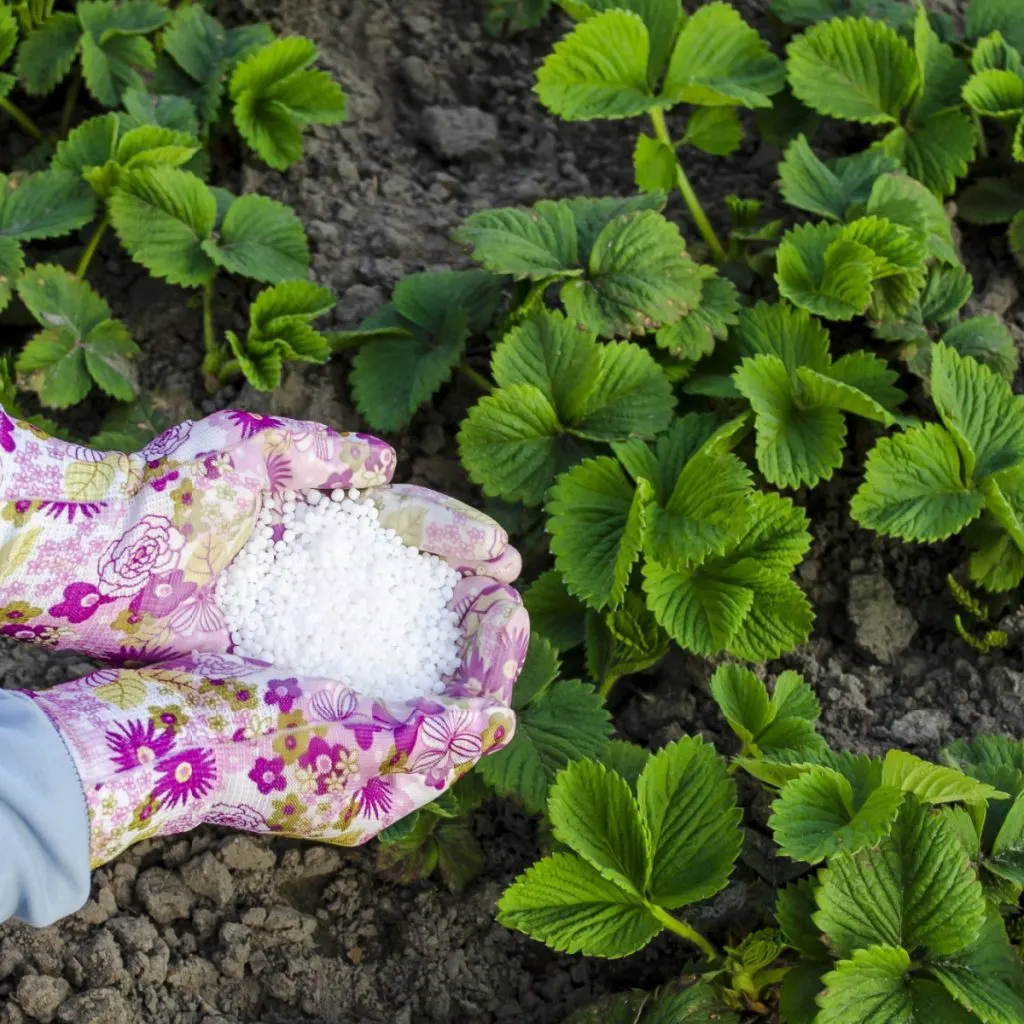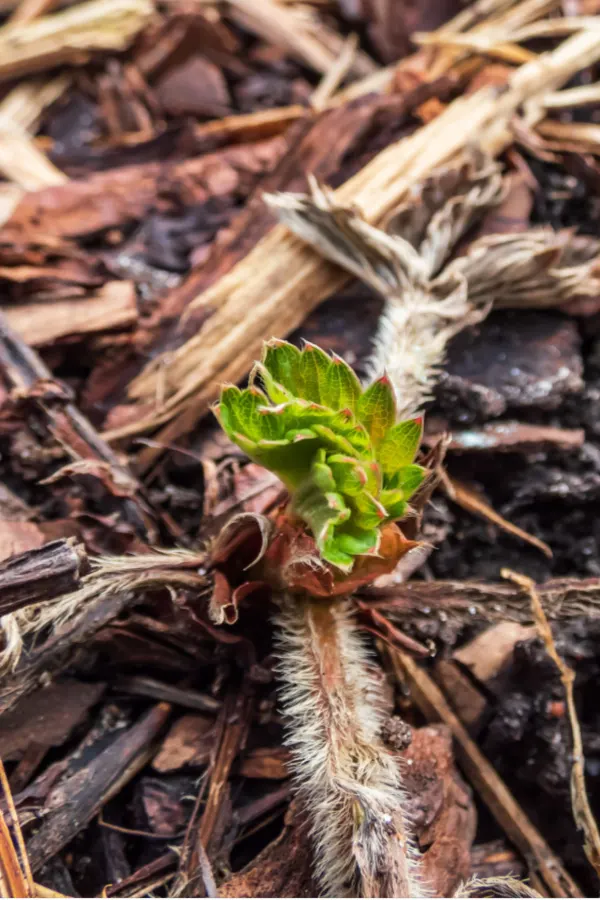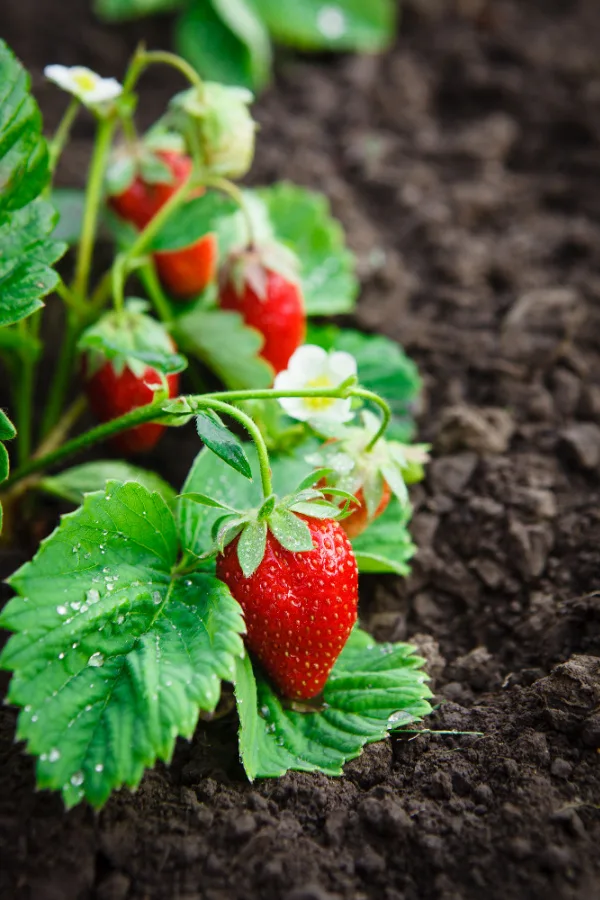Did you know that one of the most critical times to fertilize your strawberries for a bigger and better harvest is in the early spring – before they ever start to come to life?
It’s true! By simply giving a little nutrition to your strawberry plants in late winter or early spring, you can help provide them with the boost of power they need to develop strong, healthy runners – and a bigger bloom set than ever for more berries in the coming year.
Whether you grow June bearing or everbearing strawberries in a conventional patch, raised beds or even pots and containers, feeding your strawberry plants is vital to both their long term health and production. But to really have success when fertilizing, the real secret is to get your plants those nutrients early!

How To Fertilize Strawberries In Early Spring
There are actually two important times to fertilize strawberry plants – before they green up, and right after they produce. But of the two, it’s the late winter / early spring fertilizing that is the most important of all. Why? Because it’s that feeding that directly affects flowering – and the fruit that follows!
Because they are a perennial, strawberry plants continually soak in nutrients from the soil. And if those nutrients are not replaced on a regular basis, the plants health and your overall harvest will suffer.
As much as this is true with strawberries growing in the ground, it’s even more critical for those growing in the limited soil of a pot or container. The good news? Wherever and however you grow, giving your plants the food they need isn’t difficult or time consuming. It just has to be given early enough to help the plant produce more fruit.
Fertilizing Strawberries Before They Green Up In Early Spring
As strawberry plants come out of dormancy, their first order of business is to store energy in their roots for blooming and leafing out. If there is not sufficient power in the soil to do both, they will concentrate on their foliage, all at the expense of storing energy for fruiting.
Unfortunately, if you wait to give your plants the nutrients they need once they have already leafed out, it’s too late. All of the extra power will not go back to the roots for fruiting, but instead simply to help the plant grow bigger.

So how early should you fertilize? The best plan of attack is to fertilize a few weeks before plants show any signs of life at all. Or, at the very least, at the first moment your plants start to sprout greenery.
If you live in a more southerly location, this is usually in late February to mid-March. In cooler, northerly climates, late March to mid April is ideal. The key again is to simply get that fertilizer down before the plants have a full canopy of leaves.
The Best Fertilizer For Strawberries In Early Spring
So now that we’ve covered when to fertilize, let’s cover the best type and way to power your strawberry plants. For strawberries – the ideal choice is a granular, slow release fertilizer. And one with an equal balance of nitrogen, phosphorous and potassium.
By using a granular, slow release fertilizer, the nutrients can slowly soak into the roots. This keeps the plants from getting too much power all at once, which will cause the plant to simply use the extra energy to once again grow bigger.
Listen In Below To Our Podcast On How To Grow Strawberries Like A Pro!
Select a granular fertilizer with an N-P-K ratio from 10-10-10 to 12-12-12. This balanced ratio will provide the perfect power to your plants. One that promotes steady foliage and runner growth – all while allowing the roots to store up for blooming! Affiliate Product Link: Southern Ag All Purpose Granular Fertilizer 10-10-10
As for how much fertilizer to use? On average, one cup of granular fertilizer can power about 10 plants. This ratio works well for both in ground and container plants, and for everbearing or June bearing.
Sprinkle on fertilizer around the base of plants and then lightly water in to set. Watering is important at this stage as it will help the granular fertilizer to begin to break down into the soil. If you had your strawberry plants covered for winter, pull back the mulch before fertilizing.
Once the fertilizer is down, you can then water in and re-mulch. At this point mulch with a few inches of fresh mulch to help keep weeds out and moisture in. Mulch will also help regulate the soil temperature for your plants early in the year.
Fertilizing Strawberries After They Fruit
In addition to early spring fertilizing, a second smaller feeding after your plants fruit can really help your strawberries to stay strong and healthy. For this second feeding, the timing will depend on what type of strawberries you are growing.
June bearing plants can be fertilized in early summer a second time right after they fruit and are pruned back. This feeding helps the to regrow foliage and power their roots for the upcoming winter.
For a summer feeding, you can either use a granular fertilizer, or simply cover your plants with a few inches of fresh compost. Either will slowly work their nutrients down into the soil to recharge the plants.
One thing you do not want to do is fertilize June bearing strawberry plants in late summer or fall. A late feeding will cause unwanted late growth. And growth that is highly susceptible to winter damage. Fertilize right after they fruit – and let your plants simply grow out on their own until fall.
Fertilizing Everbearing Strawberries A Second Time
Beyond fertilizing everbearing strawberries in the early spring, they too can benefit from a second feeding after their fruit throughout the spring and summer. For these plants, however, a light fall feeding is the best course of action.
Once your everbearing plants start to cease production in early fall, apply a light dose of all purpose granular fertilizer or a few inches of compost on top. This will help the plants to store energy up for winter dormancy and for next year’s early fruiting cycle.
If you are interested in planting strawberries for the first time this year – be sure to check out our article: The Secrets To Planting & Growing Strawberries. Here is to fertilizing you strawberries this year for big blooms – and a big harvest! Happy Gardening – Jim and Mary.
Old World Garden Farms
Jim and Mary Competti have been writing gardening, DIY and recipe articles and books for over 15 years from their 46 acre Ohio farm. The two are frequent speakers on all things gardening and love to travel in their spare time.
As always, feel free to email us at thefarm@owgarden.com with comments, questions, or to simply say hello! You can sign up for our free email list in the subscribe now box in the middle of this article. Follow us on Facebook here : OWG Facebook. This article may contain affiliate links.

